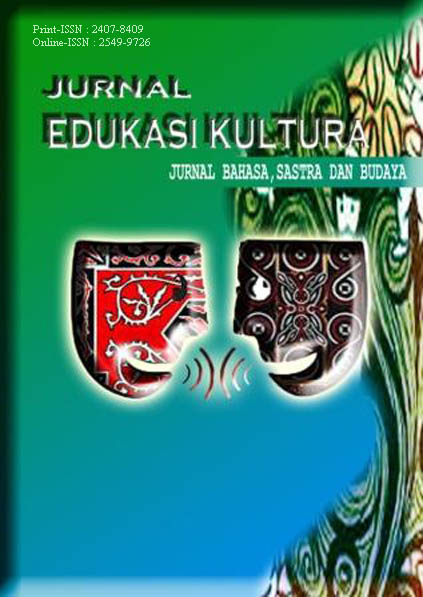Penggunaan Media Digital berbasis Kearifan Lokal sebagai Strategi Mengatasi Kesulitan Belajar Matematika Siswa Sekolah Dasar
DOI:
https://doi.org/10.24114/edukasikultura.v12i1.66229Abstract
This study discussed the challenges faced by elementary school students in learning mathematics as well as the potential of digital media to solve the problem. The purpose of this research is to explore the usage of media in digital marketing to increase students’ comprehension of mathematics. The method used in this research is qualitative with a literature study approach that collects data from several theories and literature. This research involves an analysis of group characteristics, composed of academics and educators, and focuses on the effectiveness of the digital media to enhance student engagement and learning outcomes. The discovery showed that digital media could increase students’ motivation and understanding, although there were challenges such as the gap of technology access and lacking adequate teacher training. In conclusion, integrating digital media with the teaching and learning of mathematics is expected to make a significant contribution to effective teaching methods in the digital era.References
Anggraeni, S. T., Yuliana, R., & Fitriani, N. (2020). Representasi Visual dalam Pembelajaran Matematika: Upaya Meningkatkan Kemampuan Konseptual Siswa SD. Jurnal Ilmiah Pendidikan Dasar, 5(3), 76–84.
Arsyad, A. (2021). Media Pembelajaran. Jakarta: Rajawali Pers.
Azhar, A. (2019). Teknologi Informasi dan Komunikasi dalam Pendidikan. Jakarta: RajaGrafindo Persada.
Dwi, R. S., Lestari, N., & Wahyudi, A. (2021). Pengaruh Media Interaktif Terhadap Pemahaman Konsep Matematika. Jurnal Teknologi Pendidikan, 9(1), 23–30.
Fitriani, L., & Sukarno. (2022). Penerapan Media Pembelajaran Digital Berbasis Aplikasi dalam Pembelajaran Matematika di Sekolah Dasar. Jurnal Pendidikan Matematika Dasar, 4(2), 88–97.
Hamalik, O. (2018). Proses Belajar Mengajar. Jakarta: Bumi Aksara.
Hidayat, A., & Susilowati, R. (2021). Pemanfaatan Media Digital Interaktif untuk Meningkatkan Motivasi Belajar Siswa Sekolah Dasar. Jurnal Pendidikan Dasar Nusantara, 6(1), 45–52.
Mayer, R. E. (2009). Multimedia Learning. New York: Cambridge University Press.
Munir. (2017). Pembelajaran Digital. Bandung: Alfabeta.
NCTM (National Council of Teachers of Mathematics). (2014). Principles to Actions: Ensuring Mathematical Success for All. Reston, VA: NCTM.
Ningsih, Y. A., & Zulkardi. (2020). Pengembangan Media Pembelajaran Matematika Berbasis Komputer Interaktif untuk Siswa SD. Jurnal Pendidikan Matematika, 14(2), 105–114.
Nuraini, I., & Pratiwi, D. (2020). Efektivitas Media Digital Berbasis Android dalam Meningkatkan Hasil Belajar Matematika. Jurnal Edukasi Matematika dan Sains, 8(1), 34–42.
Prastowo, A. (2015). Panduan Kreatif Membuat Bahan Ajar Inovatif. Yogyakarta: DIVA Press.
Putra, Z. A. (2021). Kesiapan Guru dalam Menggunakan Media Digital pada Pembelajaran Daring di SD. Jurnal Pendidikan dan Teknologi, 10(1), 112–120.
Rahmawati, D., Sari, M., & Wibowo, H. (2022). Pemanfaatan Media Konkret dalam Pembelajaran Matematika di Sekolah Dasar. Jurnal Pendidikan Dasar Indonesia, 7(2), 45–55.
Roestiyah, N. K. (2014). Strategi Belajar Mengajar. Jakarta: Rineka Cipta.
Rusman. (2020). Model-Model Pembelajaran: Mengembangkan Profesionalisme Guru. Jakarta: RajaGrafindo Persada.
Silvia, A., & Wahyuni, D. (2021). Pembelajaran Matematika Berbasis Digital: Alternatif Solusi Menghadapi Keterbatasan Belajar Tatap Muka. Jurnal Teknologi Pendidikan SD, 6(2), 56–64.
Suparman, A. (2020). Desain Instruksional Modern: Panduan Para Pengajar dan Inovator Pendidikan. Jakarta: Erlangga.
Yulianti, T., & Rachmadtullah, R. (2021). Pengaruh Media Digital Interaktif terhadap Kemampuan Berpikir Kritis Siswa dalam Pembelajaran Matematika. Jurnal Inovasi Pendidikan Dasar, 7(1), 67–76.
Downloads
Published
How to Cite
Issue
Section
License
Copyright (c) 2025 Hanif Luthfi Siregar, Christianov Immanuel, Ahd Rifki Al Parwis, Elvi Mailani

This work is licensed under a Creative Commons Attribution 4.0 International License.

This work is licensed under a Creative Commons Attribution 4.0 International License
Authors who publish with this journal agree to the following terms:
- Authors retain copyright and grant the journal right of first publication with the work simultaneously licensed under Creative Commons Attribution 4.0 International License that allows others to share the work with an acknowledgement of the work's authorship and initial publication in this journal.
- Authors are able to enter into separate, additional contractual arrangements for the non-exclusive distribution of the journal's published version of the work (e.g., post it to an institutional repository or publish it in a book), with an acknowledgement of its initial publication in this journal.Penulis.
- Authors are permitted and encouraged to post their work online (e.g., in institutional repositories or on their website) prior to and during the submission process, as it can lead to productive exchanges, as well as earlier and greater citation of published work (Refer to The Effect of Open Access).



